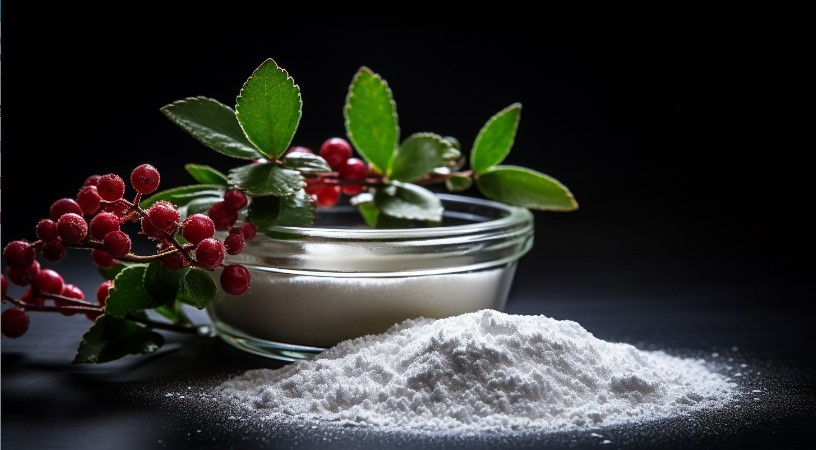알파 알부틴의 미백 메커니즘

α Arbutin has wide applicability in the cosmetic and pharmaceutical industries and has a high market value.
alpha arbutin powder 혜택
alpha arbutin powder for skin whitening
α-arbutin and β-알부틴 is a natural skin lightener, alpha-arbutin powder acts as a safer alternative to other harmful skin lighteners. This article introduces in detail. 알부틴 is found in many plant families, such as marjoram, cranberries, blueberries, and several types of pears. Arbutin effectively reduces melanin production by inhibiting tyrosinase. There are two isoforms of arbutin, alpha arbutin (4-hydroxyphenyl-α-D-glucoside) and beta arbutin (4-hydroxyphenyl-β-diglucoside). Alpha and β-arbutin have different rotational configurations, but the same formula structure (Couteau et al., 2016). Beta-arbutin is generally extracted from the leaves and peels of various plants. However, alpha-arbutin is not naturally occurring and can be synthesized by microbial enzymes or microbial biosynthesis. Interestingly, alpha-알부틴 is more effective than natural arbutin in inhibiting tyrosinase activity (Garcia-Jimenez et al., 2017). At the active site of tyrosinase, the α-glucoside bond exhibits stronger affinity than the β-glucoside bond. The 50% inhibitory concentration (ic50) of α-arbutin for human tyrosinase was 2.0 mM, while the 50% inhibitory concentration (IC50) for natural arbutin was greater than 30 mM. The inhibitory effect of α-arbutin on melanin biosynthesis was studied in cultured melanoma cells and human skin models, and the results showed that α-arbutin could effectively inhibit melanin synthesis without cytotoxicity (Sugimoto et al., 2004). α-arbutin can inhibit mouse melanoma tyrosinase, and its inhibitory effect is 10 times stronger than β-arbutin. α-arbutin does not inhibit the growth of HMV-II cultured human melanoma cells, but can effectively inhibit the synthesis of melanin, suggesting that α-arbutin is effective and safe in the treatment of hyperpigmenemia. Due to its molecular structure, alpha arbutin acts similarly to hydroquinone, but with less irritation and melanocytic toxicity. It also does not cause exogenous aging and is less likely to cause irritation and sensitization, making it a more tolerable alternative to hydroquinone. This protects the skin from sunlight-induced pigmentation and free radicals without increasing the skin’s sensitivity to sun exposure. It lightens skin tone by diluting discoloration caused by inflammation and environmental stress. It also solves the problems of glycosylation, skin yellowing and loss of elasticity caused by sugar. Commercially, alpha-arbutin is synthesized using an enzyme that catalyzes the selective transglycosylation of alpha-heteroheads between a glucose-based donor and hydroquinone as a receptor.
Tyrosinase is a mixed functional enzyme containing copper. It is widely distributed in nature, including animals, plants, fungi and microorganisms. It helps in the production of melanin, which causes skin pigmentation and protects the skin from skin damage caused by ultraviolet light. Tyrosinase has been reported to catalyze two reactions. First, it triggers the o-hydroxylation of monophenols (tyrosine), converting them to o-diphenol (LDOPA)(monophenolase activity). Secondly, it catalyzes the oxidation of o-diphenol, converting it into o-quinone (diphenol enzyme activity). Tyrosinase plays an important role in the production of melanin. Melanin protects the skin from skin damage caused by ultraviolet light and is responsible for the formation of skin color. However, pigmentation disorders (melasma, freckles, etc.) can cause serious aesthetic problems for humans. α-arbutin is synthesized by enzymatic glycosylation of hydroquinone. It directly inhibits melanosomal tyrosinase activity or competes with tyrosinase as a substrate for active sites, thereby causing skin brightening. Qin et al., 2014 studied the mechanism of α-arbutin by investigating the effects of mushroom tyrosinase on the activities of monophenolase and diphenolase. α-arbutin has dual effects on monophenolase and diphenolase activity of mushroom tyrosinase. Alpha-arbutin inhibits the homeostasis reduction of enzyme activity during the monophenolase reaction (suicide inactivation of the active site of tyrosinase). In addition, a characteristic lag period was observed during the oxidation of tyrosine during monophenolase activity. The lag time increased dose-dependent with the increase of α-arbutin concentration.
백비타
